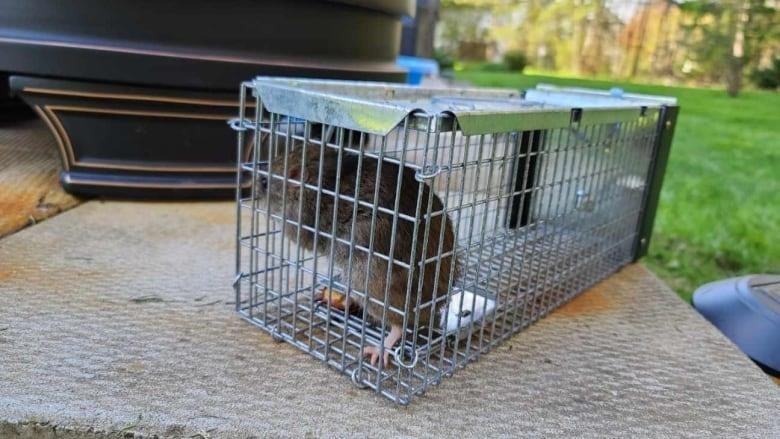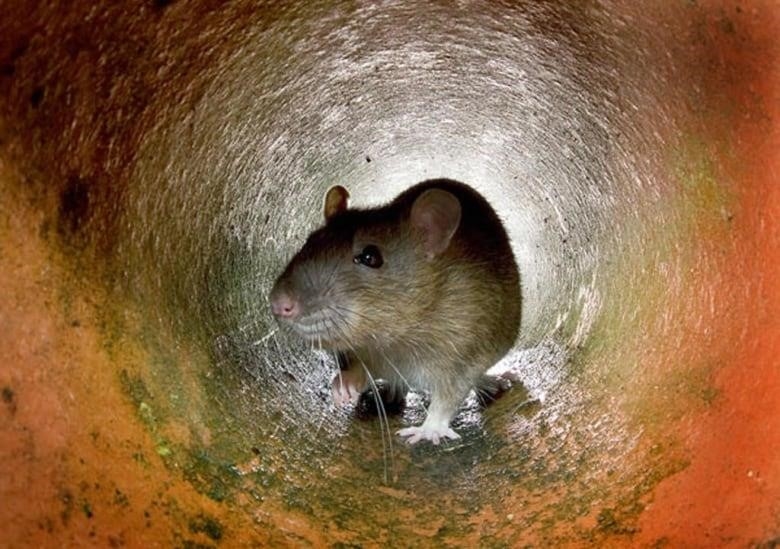
As pest problems are getting worse, here are some tips on what you can and can’t do to get rid of them
Rats and people are always at odds with each other, but all signs point to the rodents winning this year in Ottawa.
Compared to the same time last year, the city has gotten 11% more calls about rats in the first five months of 2023. Bill Dowd is the president and CEO of Skedaddle Humane Wildlife Control. He said that so far this year, his company has gotten about 25% more calls in the Ottawa area about getting rid of rodents.
Dowd said that construction projects, such as the LRT project, could have spread rodents. If restaurants closed because of the pandemic, they might have moved away from where they usually got food and into residential areas.
But he said that rodent problems are getting worse everywhere his company works.
Ottawa has brought back a group called the Rat Mitigation Working Group to help coordinate its plan. But what should people do while they wait?
“There are a lot of rules and laws that can be hard for a homeowner to understand,” said Dowd.
Here’s an overview of what you can, can’t, should, and shouldn’t do to keep rats and other pests away from your property.
Can I kill rats
Yes. In fact, Ontario law lets you chase, catch, or kill a lot of common urban pests if you have a good reason to think they are hurting or about to hurt your property.
The Ministry of Natural Resources didn’t say what animals have to do to make this belief true, but a spokesperson said that no permission or approval is needed.
The City of Ottawa confirmed that there are no extra rules about how to deal with pests or wild animals.
Can I use poison to kill the rats
It depends on the poison. The Fish and Wildlife Conservation Act makes it illegal to kill or hurt wild animals with poison. The ministry said that means rats and mice, unless the Pesticides Act says otherwise.
The province’s Environment Ministry said that people can kill rodents in and around their homes with pesticides marked for domestic use, but only professionals or farmers can use pesticides marked commercial, industrial, or agricultural. Some can only be used inside, while others can be used up to 15 meters from a building. The label on the pesticide will tell you.
Some have rules about how they can be used to keep kids, pets, and wildlife safe. Also, the federal government bans some common rat poisons, such as warfarin, unless they are put in bait stations that are hard to mess with.
“They have to be in what we call “special black bait boxes” that are heavy,” said Dowd.”There are strict rules about where and how to put those rodenticide boxes, whether they are outside or inside.”
What kinds of traps can I set
The ministry says that it is against the law to catch rats or other pests with glue or glue traps. Dowd said that it is also cruel.
“We get calls where mice and rats are just yelling, so we go check it out.”A homeowner has been hearing the rodent’s distressing screams all night because it is stuck on this glue board,” he said. “Those really should never be used.”
He said that the old-fashioned snap traps are the most humane and effective. The Ministry of Natural Resources confirmed that they are not regulated by the law, but they can’t be used to catch or hurt other wildlife.
Dowd said, “Of course, you don’t want to put those outside where kids or animals can get into them.” “You can put them in one of these bait boxes or another safe place.”

What about other animals
Dowd said that raccoons, squirrels, skunks, birds, and bats are “the five real culprits that infest homes throughout the Ottawa region.”
Raccoons and squirrels don’t have many special protections, but it is illegal to destroy their nests without a permit. Skunk dens are fair game.
Again, you can only catch or kill these animals if they are about to hurt your property. If they don’t, they have to follow the rules about hunting and trapping wildlife. You’ll need a license if you’re not a farmer.
How can I catch them or get rid of them
There are rules about what types of traps you can use. Traps with teeth or serrations on their jaws, hooks or sharp points that could hurt an animal, and some types of snares are all against the law.
For some traps, there are rules about who can use them. Many types of body-gripping traps can only be used by farmers and trappers who have a license to do so.
“These kinds of traps hurt or kill children, cats, and dogs,” said Dowd.
The law limits what you can do if you catch a wild animal without killing it. You have to give it to them within 24 hours. You can only release it within a one-kilometer radius of where you caught it, and only into a similar habitat as close as you can get.
Dowd said that 70% of animals that are moved to places far away die. During the time when babies are born, it can be worse.
“You don’t want to catch a mother squirrel, skunk, or raccoon, take her way out into the woods, and then let her go, because that means the babies will die,” he said.
The law also says that you have to kill or treat the animal in a kind way. Dowd said that some traps can lead to “a very slow and painful death,” and that some DIY solutions can do the same.About 10 years ago, a man in Toronto admitted to killing three baby raccoons with a shovel. He was charged with animal cruelty.
Plan to kill a wild animal in Ottawa? Even if you have a permit, the Discharge of Firearms Bylaw says that you can’t do that anywhere but the most rural parts of the city.
If I follow these rules, am I allowed to bother, catch, or kill anything that hurts my property
No, moose, woodland caribou, American elk, and white-tailed deer are not allowed to be harassed, caught, or killed to keep them from hurting property.
Some of the local mammal species, such as the eastern wolf, are threatened or endangered. The same is true for many types of birds and some types of bats. A different law protects them.
It says that no one can hurt, kill, chase, catch, or hurt any of these animals, or damage or destroy their habitats.
There are some exceptions, but they are limited. You can only kill, bother, or catch threatened or endangered animals if you have a good reason to think that someone or something will be hurt soon.
Under a deal with the Environment Ministry, you can only kill, capture, or bother the animal to keep it away from your property. It may say in the contract that you have to hire a professional.
Is that it
Dowd said that his company doesn’t get many calls about endangered species getting in. But there is one common pest animal that is protected in a special way.
It’s a Canada goose, and these birds can be very mean.
“Canada geese can do a lot of damage. They keep going to the bathroom. Dowd said, “In their poop, there are a lot of parasites that can be passed on to humans.” They are safe because of a federal law.
The Migratory Birds Convention Act, which comes from a treaty with the U.S., protects the Canada goose because it is a migratory bird. Pigeons and gulls are the same way. It says that without a permit, you can’t hurt the birds, their eggs, or their nests.
Dowd said that dealing with Canada geese requires a lot of paperwork, even for him.
He said, “There are a lot of rules and laws we need to follow.”
What about insects
Some insects, like the rusty-patched bumble bee, the nine-spotted lady beetle, and the mottled duskywing, are in danger or on the verge of extinction. They are protected in the same way as other species that are in danger of going extinct.
Other insects, like monarch butterflies, are called “specially protected invertebrates.” They have to follow the same rules as rats and other pests that bother people. To protect your property, you can kill them.
Aside from such species, invertebrates have no special protections whatsoever. You can kill or capture them at will, though the Pesticides Act will again regulate the use of poisons.
Even if I can kill these animals, should I
Capturing or killing rodents and other pests can be a fruitless endeavour, according to Dowd. There will always be others ready to take their place, so the best strategy is taking measures to fortify your home.
“Everybody assumes you trap it and take it away, that’s the solution, but they’ve just inundated our cities nowadays,” he said. “It’s just gotten so much out of control.”
He said rats reproduce so quickly — they can reach sexual maturity in as little as three weeks — that it’s near impossible to keep up with the numbers through trapping or killing.
“Two breeding rats, research has shown, in one year, will generate just under 12,000 rats,” Dowd said.
The trick is keeping them outside. He said mice can fit through an opening in your home about the size of a dime, while a rat needs one the size of a quarter.
“A homeowner needs to be very, very diligent,” he said. “Any of these cracks or crevices need to be sealed up.”
It’s also essential to deny wild animals food sources. Dowd said he avoids putting his garbage out until morning, since many pests are nocturnal. He also advises against spreading out birdseed, which is “like a magnet for rodents.”
“We’ll see some homes where people are feeding the birds, but the rodent population is just astounding,” he said.
The Ministry of Natural Resources agreed that killing, even when legal, is far from the best choice.
“The best approach to addressing human-wildlife conflict is to address the underlying causes of why wildlife are attracted to human spaces. Generally, killing or relocating wildlife is not a long-term solution as others will simply move in,” it said in a statement.
“The ministry encourages persons take steps to prevent conflicts before considering lethal or invasive action.”
